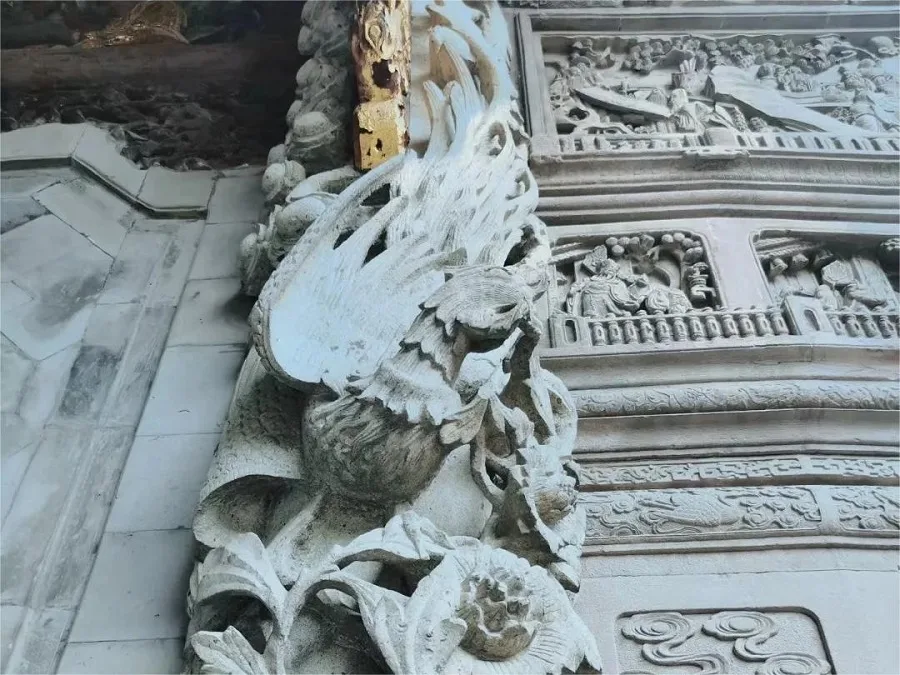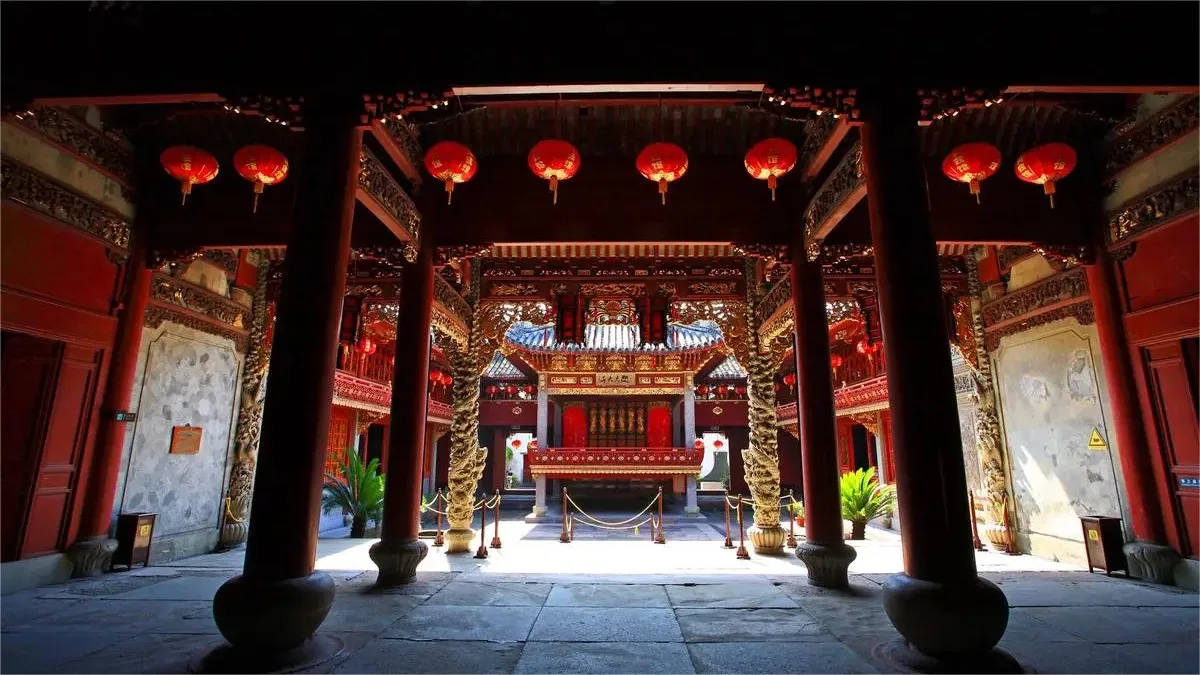Qing’an Guild Hall (庆安会馆), also known as the Tianhou Palace, was completed in the third year of the Xianfeng reign of the Qing Dynasty (1853). It served as a temple for worshiping the Heavenly Queen Mazu and as a venue for industry gatherings. It is one of China’s Eight Great Tianhou Palaces and Seven Great Guild Halls. It has been renovated and transformed into China’s first Maritime Folk Museum.
The architectural complex of Qing’an Guild Hall, facing east to west, covers an area of approximately 3,900 square meters. Originally, it featured a central axis with a screen wall, a water reception pavilion, a palace gate, a front hall (with an attached stage), a main hall (also with an attached stage), a rear hall, side chambers, and auxiliary rooms. The main hall, spanning five bays wide, showcases traditional Ningbo architectural decorations such as vermilion-gilded wood carvings, brick carvings, and stone carvings, giving the entire building a magnificent and resplendent appearance. The front theater stage was used for ceremonies dedicated to Mazu, while the rear theater stage was used for theatrical performances during industry gatherings.
Table of Contents
- Basic Information
- Location and Transportation
- Highlights of Qing’an Guild hall
- Vlog about Qing’an Guild Hall
- Attractions near Qing’an Guild Hall
Basic Information
| Estimated Length of Tour | 1 – 2 hours |
| Ticket Price | 10 RMB |
| Opening Hours | 8.30 – 16.30; Last admission: 16.00 |
| Telephone Number | 0086-0574-87330030 0086-0574-87700187 |
Location and Transportation
Qing’an Guild Hall is located at 156 Jiangdong North Road, Yinzhou District, Ningbo, Zhejiang Province, China. To get there, you can choose one of the following ways:
Bus: Take bus 2, 525, 529, 821 or T61 and get off at Qing’an Guild Hall Stop (庆安会馆站).
Metro: The closest metro station to Qing’an Guild Hall is Jiangxia Bridge East. After getting out of the station from Exit B, walk about 500 meters to the northwest to reach the attraction.
Highlights of Qing’an Guild hall
Vermilion-gilded Wood Carvings

Vermilion-gilded wood carvings, also known as “lacquer-gilded wood carvings,” are a traditional craft dating back to the Han Dynasty, integrating wood carving, painting, inlaying, and gilding. It involves applying vermilion as a base color and overlaying it with gold leaf or gold powder. Ningbo, one of the main production areas for vermilion-gilded wood carvings in China, has a rich abundance of these carvings adorning the Qing’an Guild Hall. They are extensively distributed on the wooden components of the architecture, enhancing the grandeur of the guild hall and reflecting the feminine characteristics of Mazu as a “goddess.” The carvings depict various subjects, including folk stories such as “Wandering in the Immortal Realm,” “Teaching Children Ascend to Heaven,” and “The Three Heroes Battle Lu Bu.” Decorative elements such as brackets, beams, arches, and panels feature motifs like “Phoenix Brings Spring Flowers,” “Dragon and Phoenix Auspicious,” and “Prosperous Peony,” showcasing a rich array of flying animals, mythical creatures, and exotic flora. Carving techniques range from relief to openwork, creating a rich layering effect across the wooden components.
Stone Carvings

Stone carving has its origins in the middle period of the Old Stone Age. Among the exquisite stone carvings in the Qing’an Guild Hall, the most notable are the coiled dragon pillars and phoenix peony stone pillars in the front hall. These pillars, standing over 4 meters tall, employ a combination of high relief and hollow carving techniques, creating lifelike and distinctive forms. Carved scenes of delicate architectural details on the pillar bases are rare examples of stone carving craftsmanship in China. The eight-character walls in the main hall feature various exquisite stone carvings, such as two plum garden stone screens, showcasing exceptional relief techniques. Throughout the guild hall, stone components such as staircases, pedestals, drums, pillar bases, and internal wall brackets exhibit a variety of carving styles, depicting historical narratives, coiled dragons, farming and weaving patterns, as well as floral and animal motifs through high relief, shallow carving, and line engraving techniques.
Brick Carvings

Brick carving is a craft that involves carving images and patterns on specially made fine-textured clay bricks. It originated from Eastern Zhou roof tiles, hollow bricks, and Han Dynasty portrait bricks and is commonly used in architectural components, gates, and walls. The Qing’an Guild Hall boasts a variety of brick carvings, primarily found on the palace gates and the parapets of the horse-head walls. These carvings feature diverse themes and exquisite craftsmanship. For instance, the gate tower of the guild hall is entirely composed of brick carvings. The topmost layer mimics wooden bracket sets supporting the roof. In the middle, there is a vertical plaque depicting “Two Dragons Playing with a Pearl,” with the words “天后宫(Tianhou Palace)” written in large gilded characters. Flanking the plaque are figures, flowers, birds, and animals intricately carved using high relief techniques. Below, there are shallow relief depictions of ancient artifacts. Inside the building, brick carvings predominantly depict folk legends and theatrical stories, with a minority featuring animals, plants, and geometric patterns.





